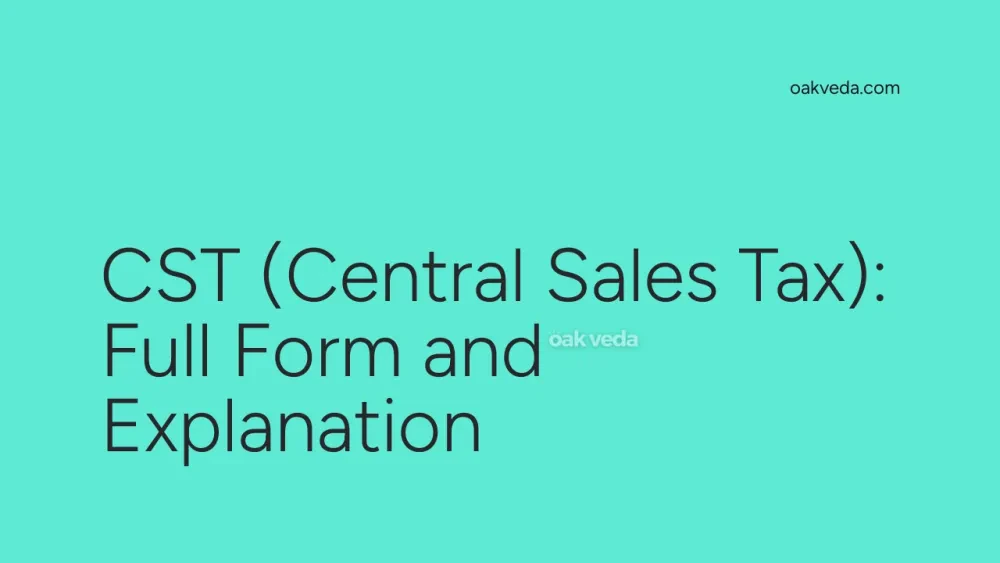
What is the Full Form of CST?
The full form of CST is Central Sales Tax. This abbreviation is commonly used in the context of Indian taxation and commerce. CST plays a crucial role in regulating inter-state trade within India and has been a significant part of the country's tax structure for decades.
What is Central Sales Tax?
Central Sales Tax is an indirect tax imposed on goods sold from one state to another within India. It is a tax levied by the Central Government but administered by the state governments. CST is applied when a seller from one state sells products to a buyer in another state, making it an essential component of inter-state commerce.
Origin and Development of Central Sales Tax
The Central Sales Tax was introduced through the Central Sales Tax Act of 1956. This Act was implemented to regulate and standardize inter-state trade in India. The primary objectives were to:
- Establish a uniform system for taxing inter-state sales
- Prevent double taxation
- Ensure fair distribution of tax revenue among states
Over the years, the CST Act has undergone several amendments to adapt to the changing economic landscape of India.
How does Central Sales Tax work?
CST operates on the principle of origin-based taxation. Here's how it works:
- The tax is levied by the state where the sale originates
- The seller collects the tax from the buyer
- The collected tax is then remitted to the state government where the sale originated
- The rate of CST is determined by the state government, but it cannot exceed 2% for inter-state sales
It's important to note that CST is applicable only to inter-state transactions and does not apply to intra-state sales or exports.
Functions of Central Sales Tax
The primary functions of CST include:
- Revenue generation: CST serves as a source of revenue for state governments
- Regulation of inter-state trade: It helps in monitoring and controlling the flow of goods between states
- Preventing tax evasion: CST helps in tracking inter-state transactions, making it difficult for businesses to evade taxes
- Promoting fair trade: By standardizing the tax rate for inter-state sales, CST ensures a level playing field for businesses across different states
Applications of Central Sales Tax
CST is applied in various scenarios, including:
- Sale of goods from a manufacturer in one state to a retailer in another state
- Inter-state stock transfers between branches of the same company
- Sales made to government departments or agencies in different states
Features of Central Sales Tax
Some key features of CST include:
- Origin-based tax: CST is levied by the state where the sale originates
- Single-point tax: It is charged only once during the inter-state transaction
- Non-vatable: Unlike VAT, CST cannot be offset against other taxes
- Uniform rate: The maximum rate of CST is capped at 2% for inter-state sales
- State-specific administration: While levied by the Central Government, CST is administered by individual state governments
Benefits of Central Sales Tax
The implementation of CST offers several benefits:
- Simplified inter-state trade: CST provides a standardized framework for taxing inter-state transactions
- Revenue generation for states: It serves as an important source of income for state governments
- Reduced tax evasion: The system helps in tracking inter-state sales, making it harder to evade taxes
- Promotion of domestic trade: By regulating inter-state commerce, CST encourages trade within India
Limitations or Challenges of Central Sales Tax
Despite its benefits, CST faces some challenges:
- Cascading effect: As a non-vatable tax, CST can lead to tax-on-tax situations
- Complexity: The system can be complex for businesses operating in multiple states
- Potential for double taxation: In some cases, goods may be subject to both CST and state-level taxes
- Impact on competitiveness: CST can make inter-state trade less attractive compared to intra-state transactions
Future Developments in Central Sales Tax
With the introduction of the Goods and Services Tax (GST) in India, the role of CST has significantly diminished. The GST regime aims to create a unified national market by subsuming various indirect taxes, including CST. However, understanding CST remains important for historical context and for dealing with any transitional issues.
FAQs on CST Full Form
-
Is CST still applicable in India? With the implementation of GST, CST has been largely phased out. However, it may still apply in certain specific cases.
-
What is the difference between CST and VAT? CST is levied on inter-state sales, while VAT (Value Added Tax) was applied to intra-state sales. VAT has now been replaced by GST.
-
Who is responsible for collecting CST? The seller collects CST from the buyer and remits it to the state government where the sale originates.
-
Are there any exemptions from CST? Yes, certain transactions are exempt from CST, such as sales to Special Economic Zones (SEZs) and goods returned within 180 days of sale.
-
What documents are required for CST registration? While CST registration is no longer required under the GST regime, historically, businesses needed to provide proof of identity, address, and business registration documents.
Understanding the full form and implications of CST is crucial for anyone involved in Indian commerce or taxation. While its relevance has decreased with the advent of GST, knowledge of CST remains valuable for comprehending India's evolving tax landscape.
You may be interested in:
- Wi-Fi (Wireless Fidelity): What It Means and How It Works
- IQ (Intelligence Quotient): Full Form and Meaning
- CFA (Chartered Financial Analyst) Full Form
- IATA (International Air Transport Association)
- OTP (One Time Password): Full Form and Explanation
- pH (Potential of Hydrogen): Full Form and Explanation

